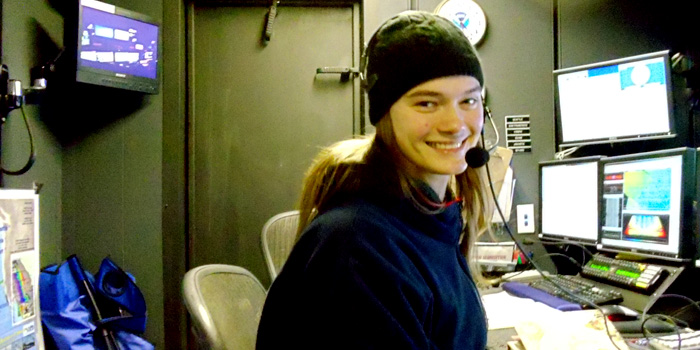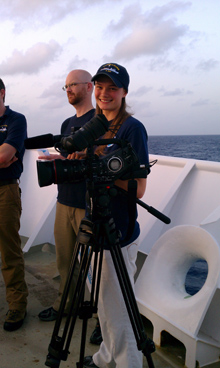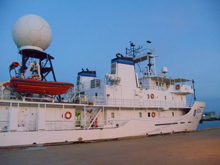
Meet Tara Smithee
Tara Smithee is an Explorer-in-Training who has had opportunities to learn mapping and ocean videography on the NOAA Ship Okeanos Explorer. Read the full text of Tara's interview below to learn more about her experiences on the ship.
About Tara's Role
What were your duties as an Explorer-in-Training?
I have worked twice on board the NOAA Ship Okeanos Explorer, once in the Gulf of Mexico, and once along the Atlantic Margin. During the first experience, I was a seafloor mapping team member, managing multibeam sonar bathymetry data as it was collected and processing the data to show detailed maps of the seafloor. For the second opportunity, I worked with the video team on board the Okeanos, learning to operate a hand-held video camera, audio equipment, and lighting and also learning to use video editing software to make a final summary video of the cruise.

Tara manning the video camera onboard the NOAA Ship Okeanos Explorer.
Which school are you attending?
I recently finished an M.S. in Earth Systems with a focus in Oceans from Stanford University. This fall, I will go back to school, pursuing an M.F.A. in Science and Natural History Filmmaking at Montana State University.
Where was your work experience located? If you were working at sea, what were your impressions of living and working on a ship?
My experiences were both at sea on the NOAA Ship Okeanos Explorer. I absolutely loved being at sea. It is such an adventure and your perspective changes once land is out of sight for a few days. The cruises are very intense because all hands are trying to jam as much work as possible into the precious sea days, but that just makes it fun. It is such a cooperative effort and everyone is exhausted by the end, but we are discovering and seeing such beautiful and amazing things that it makes every effort worthwhile.

NOAA Ship Okeanos Explorer served as Tara's home and workplace for this learning expedition.
What sparked your initial interest in ocean sciences?
My father was a commercial scuba diver and dove all over the world. He did saturation diving, and he worked on the NOAA Ship Miller Freeman as an ocean technician. I fell in love with the ocean when I did a five-week cruise called Stanford @ SEA on board the S.S.V. Robert C. Seamans operated by Woods Hole Oceanographic Institution. We did scientific research projects but also learned to crew the ship, working the sails, deploying instruments, and operating the helm. We had dolphins surfing on our bow, we navigated by taking sun and star sights, and we steered at night by the constellation Southern Cross. It was such an amazing introduction to the ocean and made me fall in love with being at sea.
What was the most personally rewarding part of your experience?
It has led me to a new career in documentary film which will hopefully allow me to give a voice to the ocean in a powerful way. I will be able to have a career that involves time at sea, highly skilled technical work, and creative license. My degree program at Montana State University will require a thesis film, and I intend to do my thesis on the Okeanos Explorer, the discoveries it has made, and the science it has generated. There are some amazing stories about the ocean just waiting to be told. I would be pleased to be able to be a voice for ocean conservation.
What is the most unexpected thing you have learned?
Methane hydrates are an ice-like form of methane crystallized with water which can be found below the seafloor in the deep ocean. I had learned about methane formations in college classes and had been intrigued. When we went to the Gulf of Mexico, our sonar equipment picked up large plumes of bubbles in the water column. We sent down the remotely operated vehicle (ROV) for a dive and clearly saw bubbles of gas being emitted from the seafloor. It was amazing to see it happening.
Please describe your final project.
For my experience with the mapping team, my final project was an ARCGIS map of the cruise which had the seafloor bathymetry data we had collected as well as the ROV dive locations and certain features we had discovered. My project for my second work experience was a video summarizing the cruise with footage I had taken in the previous weeks and interviews I had conducted with members of the science crew on board.
How do you see this experience fitting in with your future career plans?
It has set me onto a path I would never have considered before. I knew I wanted a job that involved science, but not in a research setting. Being an ocean documentary filmmaker will allow me to be both scientific and artistic as well as to continue to work with the Okeanos into the future. My experiences on the Okeanos have also led me into working with the Global Foundation for Ocean Exploration , a new nonprofit foundation geared toward furthering ocean exploration and training the next generation of explorers.
I am excited about the future of this Foundation and the things it may be able to accomplish that would greatly benefit the ocean and the life therein.